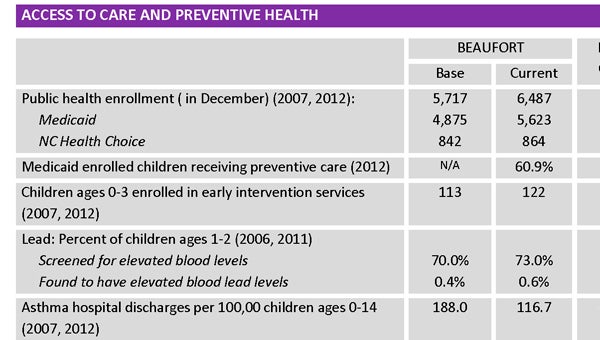Moving forward — Report shows more children insured and lower frequency of teen pregnancy
Published 3:09 pm Saturday, March 1, 2014

COURTESY OF NC CHILD | CONTRIBUTED
JUST THE FACTS: This chart shows some of the progress made in Beaufort County in regard to children’s health.
A report released last week shows significant improvement in key health indicators for children in Beaufort County from 2007 to 2012.
Those indicators include insurance coverage, dental care, teen pregnancy, child deaths and even high school graduation rates. Those gains are at odds with what’s expected during economic downturns when health outcomes typically worsen, according to NC Child, which released the report.
James A. Madson, director of the Beaufort County Health Department, believes he knows why the improvements came about.
“What this report shows is the collaboration of many people, organizations and agencies. Countywide partnerships and individual providers have started focusing on early childhood interventions and preventative care,” Madson wrote in an email to the Washington Daily News. “It is pleasing to see the efforts starting to pay off.”
The report notes the county’s poverty rate hinders efforts to make even more improvements related to children’s health.
“Poverty causes increased financial and emotional strains on families that often result in poorer health outcomes for children,” said Laila A. Bell, director of research and data at NC Child, in a new release issued with the report. “These data show that public policy actions which promote evidence-based programs and support local communities can be powerful tools to safeguard our children’s health during tough economic times.”
The report’s data care for Beaufort County shows that from 2007 to 2012 the following occurred:
- Medicaid enrollment increased by 15.3 percent and Health Choice enrollment increased by 2.6 percent, which is consistent with statewide data showing a 30 percent decline in uninsured children;
- Medicaid-eligible children who received dental care increased by 33.5 percent for children ages 1 through 5 and 31.8 percent for children ages 6 through 14;
- North Carolina’s teen pregnancy rate continued to improve, dropping 43 percent to 19.7 per 1,000 girls ages 15 through 17. The teen pregnancy rate was 22.3 per 1,000 girls in Beaufort County;
- Statewide, child fatalities continued to decline, falling 22 percent to 58.6 per 100,000 children under age 18. Beaufort County had five child deaths in 2012;
- · The graduation rate improved by 14.5 percent.
“From the health department perspective, the benefit of child enrollment in Medicaid is that it helps connect the child to services such as WIC or Care Management. WIC provides nutritional counseling and access to nutritious foods, both of which are vital to early childhood development. Care Management works to keep young, high-risk children connected to primary care and out of the emergency room,” Madson wrote in the email.
Bell addressed the county’s teen-pregnancy rate.
“It’s no coincidence that Beaufort County experienced a significant decline in its teen pregnancy rate and increase in its graduation rate over the past several years,” said Bell in the news release. “Both of these indicators have been targeted by well-funded state efforts. This improvement should give us hope that we can make progress on big problems when we’re willing to put resources behind data-driven solutions.”
NC Child’s findings for Beaufort County were not all positive, however. Key economic indicators in Beaufort County have worsened as a result of the recession and subsequent budget cuts. Specifically, the unemployment rate in Beaufort County increased from 5.7 percent to 10.9 percent from 2007 to 2012, and the median household income declined 7.5 percent to $38,256. In 2011, the most recent year for which data are available, 26.6 percent of children in Beaufort County were living in households that struggled to meet their basic nutritional needs.
“Statewide, one in four children are growing up in poverty. Food insecurity is a very serious byproduct of poverty that’s making its presence felt in Beaufort County,” Bell said in the news release. “No child should ever go to bed hungry, but unfortunately, that’s what’s happening to children across the county.”
With the elimination of the state Earned Income Tax Credit and significant cuts to unemployment benefits, according to the report, there is concern that many families could find their economic situations worsening during a slow economic recovery.
“We know that parents and communities are working hard to grow healthy children, but they cannot do it alone,” said Bell. “Advocates, providers, community and business leaders, state and federal governments must collaborate to strengthen investments in prevention programs and promote focused public policies that promote child well-being.”
Madson believe the report portends even more improvements when it comes to children’s health and related issues.
“I am very excited to see the in-roads being made in the county when it comes to child health; however, we still have some important issues to work towards. For example, 1 in 20 children born in Beaufort County did not receive adequate prenatal care and over 14% of women continue to smoke while pregnant. One issue that this report does not show is the problem we have related to childhood obesity, but that being said, we get where we want to go one step at a time, and finally we are heading in the right direction,” Madson wrote in the email.
About the report card
For 19 years, the North Carolina Child Health Report Card has monitored the health and safety of children and youth in our state. The report compiles more than 40 indicators of child-health and safety into one easy-to-read document that helps policymakers, health professionals, the media and concerned residents track children’s health outcomes, identify emerging trends, and plan future investments. The report card presents data for the most current year available, usually 2012, and a comparison year, or benchmark, usually 2007.
To download a copy of your county data card, visit: http://www.ncchild.org/sites/default/files/Avery_1.pdf
NC Child publishes more than 100 indicators of child well-being at the state and community-level online via the North Carolina state profile on the KIDS COUNT Data Center at datacenter.kidscount.org/nc.






